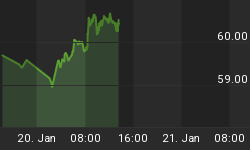The measures of investor sentiment have changed little week over week, and with the debt ceiling circus dominating the news, investors seem reluctant to make a big bet either way. One of the issues facing this rally since the mid- June lows has been the lack of short covering. Specifically, shorter term measures of investor sentiment, which we can get daily from the Rydex asset data, continue to show that investors are overly bullish. Too many bulls means not enough short covering to add fuel to any market rally. Any rally on whatever news is likely to fizzle out. Of course, the news is a resolution to the debt ceiling "crisis" which really isn't a crisis. And as I think about it, a resolution to the debt ceiling "crisis" isn't news either. It was going to get done. From this vantage, the real issue for the markets is the struggling economy.
The "Dumb Money" indicator (see figure 1) looks for extremes in the data from 4 different groups of investors who historically have been wrong on the market: 1) Investors Intelligence; 2) MarketVane; 3) American Association of Individual Investors; and 4) the put call ratio. This indicator is neutral.
Figure 1. "Dumb Money"/ weekly
Figure 2 is a weekly chart of the SP500 with the InsiderScore"entire market" value in the lower panel. From the InsiderScore weekly report: "Insider sentiment remained neutral as volume was not just seasonally, but historically low. The number of buyers (open market, non-10b5-1) and the number of transactions (open market, non-10b5-1, non-options purchases and sales) were the second-lowest figures we've ever recorded, dating back 391 weeks to January 1, 2004 (the record low for buyers was set two weeks earlier and the record low for transactees was set last week). Activity will start to pick up as earnings reports roll in, as evidenced by the fact that we had more filings yesterday than any other day since July 1st."
Of note, Mark Hulbert of MarketWatch.com has an interesting take on insider selling: "Insiders selling at unusually fast pace."
Figure 2. InsiderScore "Entire Market" value/ weekly
Figure 3 is a weekly chart of the SP500. The indicator in the lower panel measures all the assets in the Rydex bullish oriented equity funds divided by the sum of assets in the bullish oriented equity funds plus the assets in the bearish oriented equity funds. When the indicatoris green, the value is low and there is fear in the market; this is where market bottoms are forged. When the indicator is red, there is complacency in the market. There are too many bulls and this is when market advances stall.Currently, the value of the indicator is 65.94%. Values less than 50% are associated with market bottoms. Values greater than 58% are associated with market tops.
Figure 3. Rydex Total Bull v. Total Bear/ weekly
Let me also remind readers that we are offering a 1 month FREE TRIAL to our Premium Content service, which focuses on daily market sentiment and the Rydex asset data.
If you would like to have TheTechnicalTake delivered to your email in box, please click here: It's free!!!















